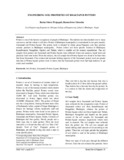Please use this identifier to cite or link to this item:
https://elibrary.khec.edu.np:8080/handle/123456789/149Full metadata record
| DC Field | Value | Language |
|---|---|---|
| dc.contributor.author | Prajapati, Ratna Shova | - |
| dc.contributor.author | Shrestha, Rameshwor | - |
| dc.date.accessioned | 2022-04-28T12:25:18Z | - |
| dc.date.available | 2022-04-28T12:25:18Z | - |
| dc.date.issued | 2017-04 | - |
| dc.identifier.issn | 2091—1475 | - |
| dc.identifier.uri | https://elibrary.khec.edu.np/handle/123456789/149 | - |
| dc.description.abstract | Pottery is one of the historic occupations of people of Bhaktapur. The tradition has been handed over to many successors, and the culture is still alive. Pottery in Bhaktapur municipality is concentrated in two parts namely; Suryamadi and Pottery-Square. The pottery work is adopted by ethnic group Prajapati, only they produce ceramic products in Bhaktapur municipality. Potters collect soil from specific location of Bhaktapur; Kamalbinayak, Nangakhel, Sipadol, and Tathali, which is suitable soil for ceramic manufacture. The soil samples from pottery site Suryamadi and Pottery-Square were collected. Grain size analysis, liquid limit and plasticity limit were tested. From the analysis, the soil sample from Pottery-Square was found to be finer than that from Suryamadi. Clay content and moisture holding capacity of the Suryamadi pottery work are greater than that of Pottery-Square pottery work. It shows that the Suryamadi pottery work had high tendency to get cracks and crumbled. | en_US |
| dc.language.iso | en | en_US |
| dc.subject | Soil, Pottery, Suryamadi, Pottery-Square, Bhaktapur. | en_US |
| dc.title | ENGINEERING SOIL PROPERTIES OF BHAKTAPUR POTTERY | en_US |
| Appears in Collections: | Journal of Science and Engineering Vol.4 | |
Files in This Item:
| File | Description | Size | Format | |
|---|---|---|---|---|
| 6_Ratna_Shova_Prajapati.pdf | 508.87 kB | Adobe PDF |  View/Open |
Items in DSpace are protected by copyright, with all rights reserved, unless otherwise indicated.
